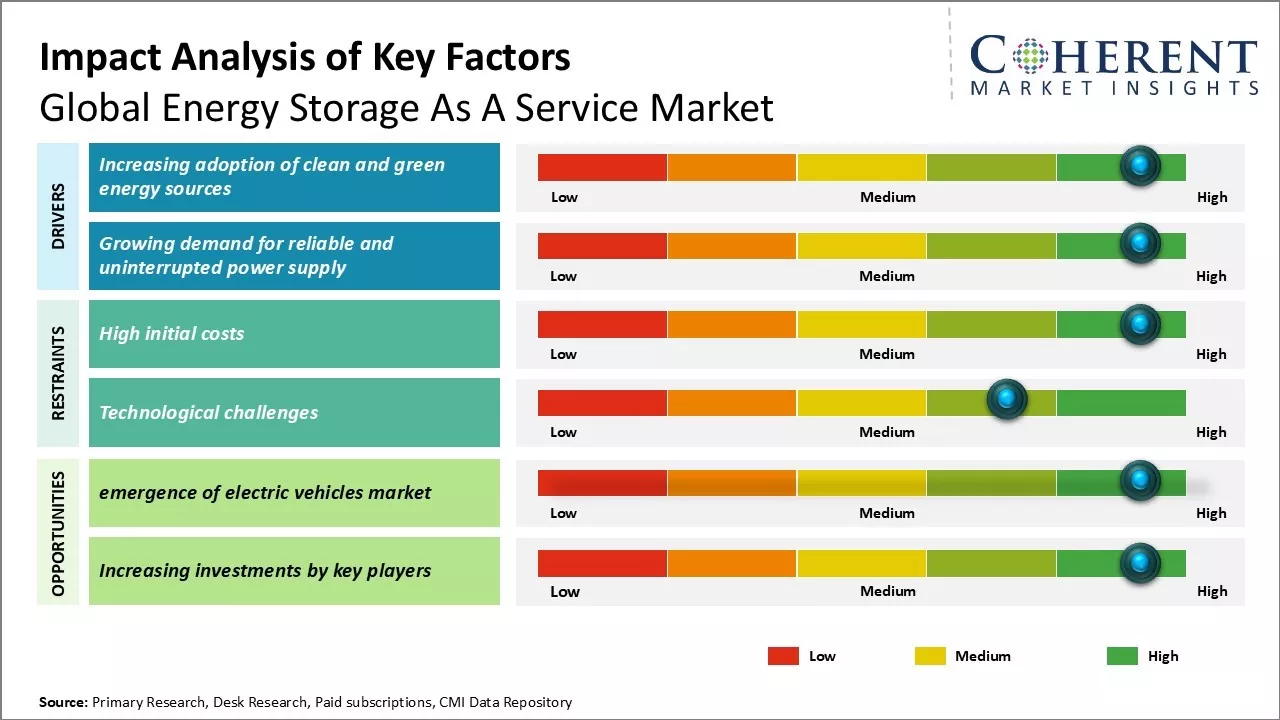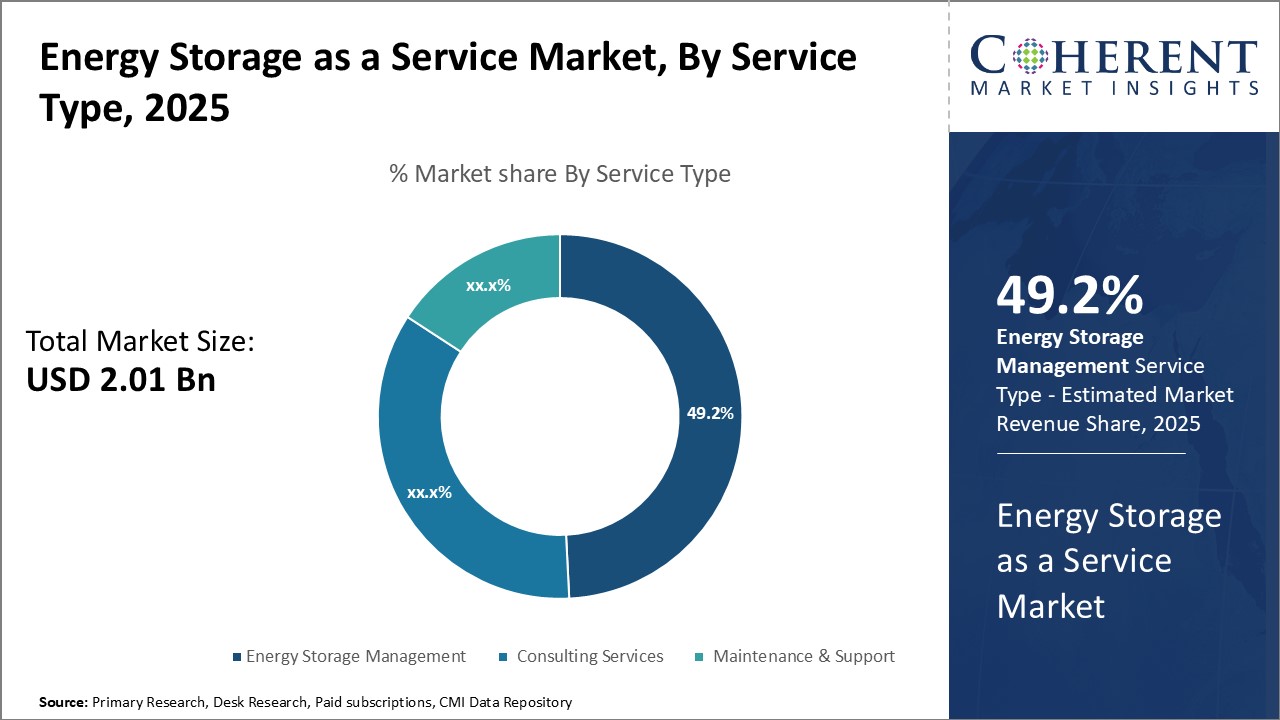Energy Storage As A Service Market Size and Trends
Global energy storage as a service market is estimated to be valued at USD 2.01 Bn in 2025 and is expected to reach USD 4.17 Bn by 2032, exhibiting a compound annual growth rate (CAGR) of 11.0% from 2025 to 2032.

Discover market dynamics shaping the industry: Download Free Sample
Increasing demand for optimizing energy consumption and reducing carbon footprint can drive many commercial and industrial consumers to adopt energy storage services.
Market Driver - Increasing adoption of clean and green energy sources
With growing concerns around environmental degradation due to emissions from fossil fuels, countries and corporations around the world have been actively pushing for transition towards cleaner sources of energy such as solar and wind. While both solar and wind energy have significant advantages over coal and natural gas-powered systems as these are renewable and sustainable, their generation and supply are dependent on climatic conditions which makes them intermittent in nature. For example, solar PV panels can only generate electricity during daytime and their output varies with intensity of sunlight during different times of the day. Wind turbine generation depends on wind speeds, which keep fluctuating.
This intermittent nature of renewable sources poses challenges for power grid management as electricity demand from consumers has to be met precisely at all times by balancing generation and supply. With increasing solar and wind capacity, power grids need to balance the variable nature of their input against predictable consumer demand patterns. Thus, energy storage solutions play a vital role by absorbing excess electricity produced during periods of high renewable generation and supplying it when required the most. Battery energy storage systems help store surplus clean energy and dispatch it to meet demand peaks or compensating for generation downtimes from intermittent sources.
Countries and regions targeting high shares of solar and wind energy as part of their climate change commitments are actively investing in deploying utility-scale battery storage projects. Europe, which has set ambitious renewable targets, witness rising interest from both private developers as well as grid operators to install battery farms at substations which can absorb power during the day from PV plants and firms and feed it after sunset to meet evening peak demand. States like California in the U.S. are pioneering use of large format battery storage solutions to manage fluctuations from their booming solar installations.
Energy-as-a-Service business models are gaining traction as these allow distributed storage asset owners to optimize utilization and monetize their investments without long term ownership. Such operating models are highly relevant for scaling up deployments required to balance the variable renewable power supply. Rising shift towards cleaner power sources can push the need for flexible energy storage infrastructure and boost adoption of storage-as-a-service.
Market Concentration and Competitive Landscape

Get actionable strategies to beat competition: Download Free Sample
Growing demand for reliable and uninterrupted power supply
Reliability of power supply has become a critical requirement for both industrial and commercial consumers. Any outage or fluctuation impacts productivity, disrupts operations and leads to heavy losses. While widespread electrification has boosted economic growth, it has also increased vulnerability of all sections to grid failures as more and more processes and services have become dependent on continuous availability of quality power. This rings especially true for digital infrastructure and data centers supporting connected world which have near-zero tolerance for power disruptions.
Reliability needs have only escalated amidst uncertainties around natural disasters becoming more frequent and varied due to climate change impacts. Extreme weather events from hurricanes to wildfires have exposed vulnerabilities of conventional power grids and caused massive and long duration outages over large areas. The pandemic has further underscored how fragile and interdependent our systems have become, bringing into sharp focus the economic and social costs of unstable electricity services.
Distributed energy resources are supplementing conventional generation in many parts of the world. While decentralization enhances energy access and resilience, it also introduces complexity needing advanced coordination and control. Energy storage offers an effective way to firm up intermittent DERs and ensure reliability at both transmission and distribution levels. It provides the needed flexibility to constantly match supply with dynamic consumption patterns by soaking up excess energy and feeding it when generation declines.
Reliable power supply supported by energy storage infrastructure as a utility service is gaining popularity among commercial and industrial consumers as well as utilities striving to strengthen grids against vulnerabilities.
Key Takeaways from Analyst:
Global energy storage as a service market growth is driven by rising need for reliable and affordable energy and rising deployment of renewable energy across several countries. However, intermittency associated with solar and wind energy generation requires efficient storage solutions. Energy storage as a service allows commercial and industrial consumers to obtain energy storage without upfront capital costs. This pay-as-you-go model attracts many customers who want to supplement their energy needs through storage. Technological advancements makes storage more effective and affordable. Lithium-ion battery prices have declined sharply in recent years.
North America currently dominates the market due to supportive policies promoting the adoption of renewables and energy storage projects. However, Asia Pacific is expected to emerge as the fastest growing regional market. Countries like China, Japan, and South Korea are planning large-scale renewable energy integration that can boost the need for flexible energy storage platforms.
The market is also witnessing the entry of new players offering innovative service-based models. While high initial investment can hamper the market growth, partnerships with financial institutions can address this restraint. With battery costs declining and business case for storage increasing, there will be huge adoption of energy storage as a service in the near future.
Market Challenge - High initial costs
Global energy storage as a service market growth can be hampered due to high initial capital costs associated with energy storage solutions. Setting up large-scale battery energy storage facilities requires massive upfront investment in procuring battery modules, power conversion systems, bi-directional inverters and related infrastructure. For commercial and industrial customers, such high capital expenditure poses significant financial hurdles. Even for utilities and grid operators, scaling up battery energy storage are quite expensive that put pressure on return on investments. The costs of battery technologies like lithium-ion have still not come down significantly to levels that ensure reasonable payback periods. This high barrier to entry poses serious adoption challenges for energy storage as a service globally.
Market Opportunity: Emergence of Electric Vehicles Market
Rapid growth of electric vehicles market worldwide can offer growth opportunities for the global energy storage as a service market. With many countries aiming to ban new petrol and diesel cars by 2030, there will be huge demand for electric vehicles in the near future. This rising EV adoption indirectly benefits the energy storage industry since EV batteries can be utilized for providing storage as a service when the vehicles are parked for long durations. Aggregators are setting up innovative business models where these can dispatch stored energy from stationary vehicle batteries to the grid during peaks. This emergence of electric vehicles can open a new revenue stream for the energy storage industry and improve the utilization rates as well as economics of large battery deployments.

Discover high revenue pocket segments and roadmap to it: Download Free Sample
Insights, By Service Type: Optimizing Operations Boosts Demand for Energy Storage Management
By service type, energy storage management segment is estimated to contribute the highest market share of 49.2% in 2025, owing to its capabilities in optimizing energy storage asset operations. As energy storage deployment increases worldwide, the need for sophisticated management systems that maximize the value and lifetime of these assets has become imperative. Energy storage management solutions provide utilities and other customers with centralized control and monitoring of all energy storage facilities. These helps optimize charging/discharging cycles based on grid conditions and electricity price signals to minimize costs. Energy storage management software performs critical functions like thermal and power controls, state of charge calibration, and failure detection that keep energy storage systems performing efficiently over many years of use.
Key advantages of energy storage management include improved energy arbitrage revenues through intelligent scheduling, enhanced power quality through reliable frequency regulation services, and deferred infrastructure upgrades by reducing peak demand. Utilities rely on energy storage management to derive multiple revenue streams from a single energy storage installation. For example, storage assets can provide hourly shifting of solar/wind power during daytime overproduction and return the stored energy during evening peak hours. Management platforms coordinate these complex operations seamlessly based on dynamic pricing. These have emerged as the defining technology enabling utilities to maximize the value proposition of stationary storage.
Insights, By End User: Enhancing Grid Stability
By end user, utilities segment is estimated to contribute the highest market share of 41.1% in 2025. This sector primarily leverages energy storage solutions for enhancing grid stability, managing peak demand, and facilitating the integration of renewable energy sources. Following utilities, the commercial and industrial segment accounts for approximately 30.0% of the market share, where businesses utilize energy storage to achieve cost savings, improve energy management, and engage in demand response initiatives. Residential segment, capturing about 20.0% of the market share, consists of homeowners who deploy energy storage systems for backup power, optimizing self-consumption, and benefiting from net metering. "Others" category comprises various sectors such as agriculture, telecommunications, and emergency services, representing around 9.4% of the market share. This segmentation underscores the diverse applications of energy storage solutions across different end user categories, highlighting the pivotal role of utilities in driving market growth.
Insights, By Application: Grid Services are Critical for Accommodating Renewable Energy
By application, grid services segment is estimated to contribute the highest market share of 58.3% in 2025, owing to crucial role of energy storage in modernizing electricity infrastructure to support renewables. As the renewable energy share increases globally, intermittent resources like solar and wind are presenting new technical challenges for grid operators to maintain power quality and reliability. Energy storage deployed for grid services buffers the variability of these resources and replaces conventional sources for balancing demand. It enables greater penetration of renewables through ancillary services like frequency regulation, voltage support, and spinning reserves.
Storage assets providing frequency regulation have become indispensable for grids with high shares of solar and wind power. These inject or absorb active power almost instantaneously to counteract fluctuations from renewable generation and maintain grid frequency within acceptable bounds. This preserves power quality and prevents equipment damage or blackouts stemming from frequency deviations. Storage also delivers other essential grid services like ramping, load following and peak shaving. It shifts excess solar/wind power production during low demand periods and returns stored energy when renewable output drops during evening peaks or transitory grid disturbances.
The stable income streams from grid service value streams makes energy storage a commercially viable investment. As more countries and regions aim to achieve very high renewable energy targets, dependence on energy storage for grid flexibility will increase significantly in the future.
Regional Insights

Need a Different Region or Segment? Download Free Sample
North America currently dominates the global energy storage as a service market with an estimated market share of 40.6% in 2025. The region is home to several industry-leading companies that offer energy storage solutions and services. Countries like the U.S. have witnessed huge adoption of such services by commercial and industrial users looking to optimize energy consumption and bills. With established industry standards and a supportive regulatory environment, many potential customers in sectors such as manufacturing and real estate have willingly subscribed to storage service contracts.
The regional presence of large technology providers and energy firms can drive the market growth. Strategic collaborations between these companies ensure customers have access to cutting-edge and customized storage solutions. Given the mature renewable energy industry, the regulatory push for clean energy also increases demand for battery storage that helps integrate more intermittent power sources into the grid. Well-developed energy infrastructure and high electricity costs have made customers receptive to the cost savings promised by energy service companies.
Asia Pacific is expected to be fastest growing market for energy storage as a service. Countries like China and India witness huge demand for electricity due to industrialization and economic development. Rapid infrastructure growth has boosted requirements for reliable and affordable power. Both nations aim to expand renewable energy capacity substantially to reduce emissions. This presents a big opportunity for service providers to help balance renewable energy integration using battery systems.
Asia Pacific also hosts a burgeoning domestic energy storage industry comprising both international and local players. Given the size of their markets, major companies are making large investments to establish local manufacturing centers and supply networks. This helps them offer cost-competitive and locally-tailored services. Rising affluence levels and growing awareness of energy management make commercial and industrial prosumers highly receptive to storage services. With strong economic projections and supportive policies, the Asia Pacific region is well-poised to become the fastest growing market for energy storage as a service globally.
Market Report Scope
Energy Storage as a Service Market Report Coverage
| Report Coverage | Details | ||
|---|---|---|---|
| Base Year: | 2024 | Market Size in 2025: | USD 2.01 Bn |
| Historical Data for: | 2020 To 2024 | Forecast Period: | 2025 To 2032 |
| Forecast Period 2025 to 2032 CAGR: | 11.0% | 2032 Value Projection: | USD 4.17 Bn |
| Geographies covered: |
|
||
| Segments covered: |
|
||
| Companies covered: |
Fluence Energy Storage Company, Ambri Energy Storage Company, Stem, Inc., Swell Energy, Sunrun, Sonnen, Generac Power Systems, Engie Storage, Eos Energy Storage, Powin Energy, NantEnergy, Nidec ASI, Nuvve, Pivot Power, Quidnet Energy, Redflow, Renault, and Siemens Gamesa Renewable Energy |
||
| Growth Drivers: |
|
||
| Restraints & Challenges: |
|
||
Uncover macros and micros vetted on 75+ parameters: Get instant access to report
Energy Storage as a Service Industry News
- In August 2024, Ausgrid, a Australia-based electricity distributor, announced the launch of its energy storage-as-a-service offering as a community battery energy storage system (BESS) went online in New South Wales (NSW), Australia. This innovative initiative marks a significant milestone in the integration of renewable energy and the provision of energy storage solutions to local communities.
- In July 2024, Elli, a prominent energy solutions provider, announced its entry into the industrial energy storage business. This strategic move marks a significant expansion of Elli's portfolio, positioning the company to meet the growing demand for reliable and efficient energy storage solutions in industrial applications.
- In June 2024, JSW Energy, a leading player in the Indian energy sector, announced the commencement of construction for its new battery storage services project. This strategic initiative marks JSW Energy's entry into the rapidly evolving battery storage market, aiming to enhance its portfolio and support the growing demand for renewable energy integration and grid stability.
- In April 2024, Schneider Electric, a global leader in energy management and automation solutions, announced the launch of its all-in-one Battery Energy Storage System (BESS) designed specifically for microgrids. This innovative system represents a significant advancement in the field of renewable energy integration and microgrid technology, offering a comprehensive solution for reliable and efficient energy storage.
*Definition: Global Energy Storage as a Service Market provides energy storage systems to customers as a fully managed service. As a subscription-based service, it handles all procurement, installation, monitoring and maintenance of batteries or other storage technologies. This allows commercial, industrial and utility customers to access flexible energy storage without large upfront capital costs. In exchange, customers pay regular usage fees. The service aims to help customers lower energy costs by shifting demand, provide backup power and integrate more renewable energy sources.
Market Segmentation
- By Service Type Insights (Revenue, USD Bn, 2020 - 2032)
- Energy Storage Management
- Consulting Services
- Maintenance and Support
- By End User Insights (Revenue, USD Bn, 2020 - 2032)
- Utilities
- Commercial and Industrial
- Residential
- By Application Insights (Revenue, USD Bn, 2020 - 2032)
- Grid Services
- Peak Shaving
- Frequency Regulation
- Renewable Energy Integration
- Solar
- Wind
- Grid Services
- By Regional Insights (Revenue, USD Bn, 2020 - 2032)
- North America
- U.S.
- Canada
- Latin America
- Brazil
- Argentina
- Mexico
- Rest of Latin America
- Europe
- Germany
- U.K.
- Spain
- France
- Italy
- Russia
- Rest of Europe
- Asia Pacific
- China
- India
- Japan
- Australia
- South Korea
- ASEAN
- Rest of Asia Pacific
- Middle East
- GCC Countries
- Israel
- Rest of Middle East
- Africa
- South Africa
- North Africa
- Central Africa
- North America
- Key Players Insights
- Fluence Energy Storage Company
- Ambri Energy Storage Company
- Stem, Inc.
- Swell Energy
- Sunrun
- Sonnen
- Generac Power Systems
- Engie Storage
- Eos Energy Storage
- Powin Energy
- NantEnergy
- Nidec ASI
- Nuvve
- Pivot Power
- Quidnet Energy
- Redflow
- Renault
- Siemens Gamesa Renewable Energy
Share
Share
About Author
Yash Doshi is a Senior Management Consultant. He has 12+ years of experience in conducting research and handling consulting projects across verticals in APAC, EMEA, and the Americas.
He brings strong acumen in helping chemical companies navigate complex challenges and identify growth opportunities. He has deep expertise across the chemicals value chain, including commodity, specialty and fine chemicals, plastics and polymers, and petrochemicals. Yash is a sought-after speaker at industry conferences and contributes to various publications on topics related commodity, specialty and fine chemicals, plastics and polymers, and petrochemicals.
Missing comfort of reading report in your local language? Find your preferred language :
Transform your Strategy with Exclusive Trending Reports :
Frequently Asked Questions
EXISTING CLIENTELE
Joining thousands of companies around the world committed to making the Excellent Business Solutions.
View All Our Clients
